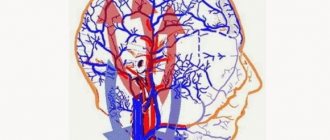Patients often complain of a feeling of numbness in their toes; sometimes unpleasant sensations appear when sitting in an uncomfortable position, especially in children when they sit on their feet. This condition usually passes quickly and does not cause any particular inconvenience. But in the case when numbness appears for no apparent reason and is constantly disturbing, a neurological problem can be suspected. Paresthesia of the limbs is a serious disease that requires treatment under the supervision of a specialist, so at the first signs of pathology you should consult a doctor.
The phenomenon of leg paresthesia and its types
Numbness occurs when nerve fibers are compressed.
Impulse conductivity is restored if the provoking factor is quickly eliminated or the position of the limb changes. The disease is most often diagnosed in older people suffering from chronic cardiovascular diseases.
Paresthesia occurs:
- The permanent form is characterized by a deterioration in sensitivity that arose against the background of concomitant diseases after surgery. Discomfort is always present regardless of the position of the legs. Degenerative, tumor, autoimmune processes in tissues, atherosclerotic obliteration of blood vessels, alcohol intoxication are accompanied by chronic paresthesias.
- A temporary type of neuropathy develops after mechanical injuries, blows, compression of a limb, or prolonged sitting in an uncomfortable position. The pathology occurs due to compression of nerve endings located close to the surface of the skin. By eliminating the cause of blocking the conduction of nerve impulses, it is possible to restore sensitivity in full.
Unpleasant sensations most often appear in the area of the feet, fingers, calf muscles and thighs. Symptoms of paresthesia intensify at night: patients suffer from cramps and leg pain. This is due to impaired blood circulation in the distal limbs when the body is in a horizontal position.
Symptoms of the disease
If paresthesia occurs in the area of the toes, patients do not notice how the skin is injured and rubbed. In the calf region, neuropathy may be accompanied by cramps, tingling, and burning. During palpation, an unpleasant painful sensation appears.
The dermis has a pale, bluish tint, cold and moist to the touch. Patients cannot warm their feet and are constantly cold. In advanced forms of obliterating diseases, the skin becomes inflamed, and areas of baldness and trophic ulcers that take a long time to heal form on its surface.
Lumbar hernias cause compression of the nerve roots, decreased pain and temperature sensitivity, and paresthesia. Symptoms of numbness and tingling radiate to the sacrum, lateral thigh, outer side of the lower leg, and the first 3 toes. Disc entrapment is accompanied by paresis of the 1st phalanx and ankle extensor muscles.
With uncompensated diabetes mellitus, irreversible damage to nerve endings and blood vessels develops. Paresthesia can occur several years after the onset of the disease and is combined with muscle weakness and autonomic disorders.
Polyneuropathy is manifested by a feeling of numbness, burning, pain, intensifying during touch. Due to impaired sensitivity, the feet are often injured, the wounds turn into purulent ulcers, which often causes the development of gangrene and amputation of the limb.
Causes and localization
Signs of pathology may occur against the background of the following diseases:
- diabetic angiopathy, polyneuropathy;
- atherosclerosis;
- endarteritis;
- Raynaud's disease;
- thrombophlebitis;
- alcohol, chemical intoxication;
- nervous system disorders;
- lower limb injuries;
- osteochondrosis, lumbar intervertebral hernia;
- heart failure;
- tumors in the spinal column or brain;
- vitamin B deficiency;
- transient ischemic attacks;
- paresis of the limbs;
- multiple sclerosis;
- vegetative-vascular dystonia;
- cerebrovascular accident.
The main cause of paresthesia is tunnel syndrome, which develops with compression of nerves in the musculoskeletal, intermuscular and fibromuscular space.
In most cases, decreased sensitivity is diagnosed in patients with metabolic disorders and infectious and allergic reactions.
When is it not recommended to postpone a visit to a specialist?
Numbness in the legs is commonly understood as loss of sensation in the lower extremities. This phenomenon can be either temporary or long-term. In this case, loss of sensitivity in certain areas, one or two limbs is possible.
Along with this problem, a person may complain of symptoms such as tingling, impaired motor function, burning, or loss of muscle tone (inability to lean on a numb limb).
If your legs go numb on a permanent basis, it is worth finding out the reasons and only after that the doctor will be able to prescribe the correct treatment. Such a problem may be a signal that a malfunction has occurred in the body, the integrity and process of restoration of nerve fibers has been compromised.
Numbness in the legs may be a symptom of one of the following diseases:
- diabetes;
- arthritis;
- oncology;
- stroke (pre-stroke condition);
- leg tunnel syndrome;
- osteochondrosis;
- phlebeurysm;
- multiple sclerosis;
- spinal tuberculosis;
- Raynaud's disease;
- polyneuropathy;
- pre-infarction state.
Some of the above diseases can significantly affect a person’s health and also lead to irreversible changes in the body. It is for this reason that if numbness in the legs has become a frequent problem, you should consult a specialist.
As a rule, in such cases it is necessary to contact such specialists as a neurologist, vertebrologist or traumatologist. Next, the doctor will conduct the necessary studies, after which it will be clear what the person is dealing with.
Modern diagnostics
If symptoms of paresthesia appear, you should contact a neurologist, endocrinologist, angiologist or vascular surgeon.
The doctor will conduct an examination, collect anamnesis, assess the general condition of the limbs and skin and prescribe instrumental and laboratory tests.
Computed electroneuromyography is most often used to diagnose neuropathies. Based on the results obtained, they look at how impulses travel along nerve fibers and identify the localization and stage of the pathology.
Ultrasound and Dopplerography of the vessels of the lower extremities is performed to determine the degree of circulatory disorders, visualize areas of obliteration, and thromboembolism. If the cause of the development of paresthesia is problems with the spine, the patient's brain undergoes a CT scan, MRI, encephalography, X-ray, and lumbar puncture. For heart diseases, ECG and EchoCG are prescribed.
Laboratory tests are necessary to determine the level of glucose, triglycerides, lipoprotein balance, and the presence of toxins in the blood.
Symptoms
The main symptom of paresthesia is numbness in the legs, but it may not appear immediately, so you need to pay attention to other signs. First, the skin in the area of the thumb at the border with the cuticle loses sensitivity, so if the patient does not feel anything when pressing on this place, it is recommended to visit a specialist. With paresthesia, symptoms of circulatory disorders appear. The legs may become marbled and cold, or have a bluish tint. Any changes in skin color should be alarming. If, in addition to numbness, pain appears when pressing on the affected area or when walking, then you should consult a doctor immediately. The feet may lose sensation completely; the patient does not feel pain, cold or hot.
Treatment methods
The regimen and drugs for therapy are selected taking into account the cause that caused the loss of sensitivity in the limbs. The main task is to identify the provoking factor, restore impulse conduction, normalize blood circulation and eliminate compression of nerve fibers.
Physiotherapy
Treatment of paresthesia of the lower extremities is carried out using electrophoresis, acupuncture, dynamic currents, magnetic therapy, mud applications, various types of massage, and physical therapy.
The procedures reduce unpleasant symptoms and stimulate neuroimpulse transmission to the affected parts of the legs.
Drug treatment
To improve the rheological properties of blood, anticoagulants are prescribed to a sick person. For vascular atherosclerosis, it is recommended to follow a low-calorie diet that excludes the consumption of animal fats.
Chemical intoxication is treated with antioxidants and a saline solution is injected in a stream. If compression of the nerves occurs due to muscle spasm, muscle relaxants and antispasmodics help relieve the unpleasant symptom.
In case of tumor genesis, consultation with an oncologist, surgical removal of the tumor, or a course of chemotherapy is required.
Numbness therapy
In most cases, numbness is a symptom of a systemic disease, which means that its treatment is aimed at combating the identified disease. The following therapeutic methods are used to eliminate numbness:
- Taking medications: NSAIDs (non-steroidal anti-inflammatory drugs), coricosteroids (hormonal drugs) and muscle relaxants,
- Physiotherapeutic procedures: ultrasound treatment, laser application, paraffin baths, mud baths,
- Manual therapy – massage, acupuncture, reflexology,
- Performing physical therapy exercises, kinesitherapy - strengthening the muscles that hold the spine with the help of dosed sports loads.
Expert opinion!
If your left leg rarely goes numb, then the following will help you quickly cope with the discomfort:
- Gymnastics for feet,
- Wearing comfortable shoes made from natural materials and orthopedic insoles,
- Walk or jog daily.
A homemade diuretic will help eliminate congestion: squeeze juice from cucumber, carrots and lemon. Mix in proportion 1:1:1. Stir a tablespoon of the resulting mixture in a glass of warm water.
Vanga's tincture will help strengthen joints: combine the yolk of a chicken egg and 5 grams of milkweed juice. Rub into the numb area of the leg.
Restores the functioning of the central nervous system with an infusion of peppermint. 40 grams of dry herb are steamed with a glass of boiling water. Leave for 4-6 hours. Drink on an empty stomach in the morning and evening before bed.
Flax seed tincture helps to quickly cope with discomfort. A tablespoon of raw material is poured into a liter of hot water and boiled over low heat for half an hour. The infusion should be warmed before use. The full course of treatment is 15 days.
Herbal baths eliminate foot fatigue and restore sensitivity. Dried flowers of mint, chamomile and birch leaves are taken in a 1:1:1 ratio and poured with boiling water. Insist for two hours. The finished broth should be poured into a basin. Soak your feet before bed for 15 minutes.
If your left leg is numb, baths with sea salt (100 grams per liter of hot water), with soda (2 tablespoons per 2 liters of water), with juniper berries (steam 100 grams of dried fruits in a liter of boiling water, add to a basin of water) are useful. and with dry mustard (2 tablespoons per liter of water).
On a note!
You can quickly restore sensitivity to your limbs using a contrast shower or bath. First, the feet are immersed in warm water, then in cold water.
Preventive measures
To prevent the development of paresthesia, it is necessary to lead a healthy lifestyle, give up bad habits, eat a balanced diet, and follow a dosed regimen of physical activity.
It is important to treat primary diseases in a timely manner; in case of chronic illnesses, preventive treatment and wellness procedures should be carried out.
Paresthesia of the lower extremities can be caused by poor circulation, compression of nerve endings in the lumbar region, or growing brain tumors. To determine the exact cause of the development of pathology and prescribe adequate treatment, you must consult a doctor and undergo an examination.
Numbness in the finger or toes on the left foot
Numbness does not always affect the entire leg; only the foot may become numb. The toes that are most often affected by numbness are the big and second toes, the area located between the second and third toes.
Pain and numbness in the feet comes from progressive neuropathy of the tibial and peroneal nerves. Compression of their nerve endings can occur in the area of the ankle joint, located above the knee joint at the back. At this point the joint exits the intervertebral canals.
The development of an intervertebral hernia provokes pinching of nerve endings, and tissue spasm occurs. The lumbar root is the cause of tingling in the fingers and soft feet. Severe pain and weakness appears in the leg. Lack of treatment may cause increased pain in the affected area (leg, foot). The patient is unable to stand on his toes due to the nature of the pain.
Features of numbness in the left foot
Numbness of the feet and pain in the leg are accompanied by symptoms:
- swelling of the foot;
- redness on the left leg, which is numb;
- severe pain that limits movement in the joints of the fingers.
Pain in left leg
If you suspect that your leg or foot is numb, you should contact a cardiologist or rheumatologist. Numbness in the left leg affects people who stand on their feet for long periods of time, enduring regular physical activity on the lower extremities.











